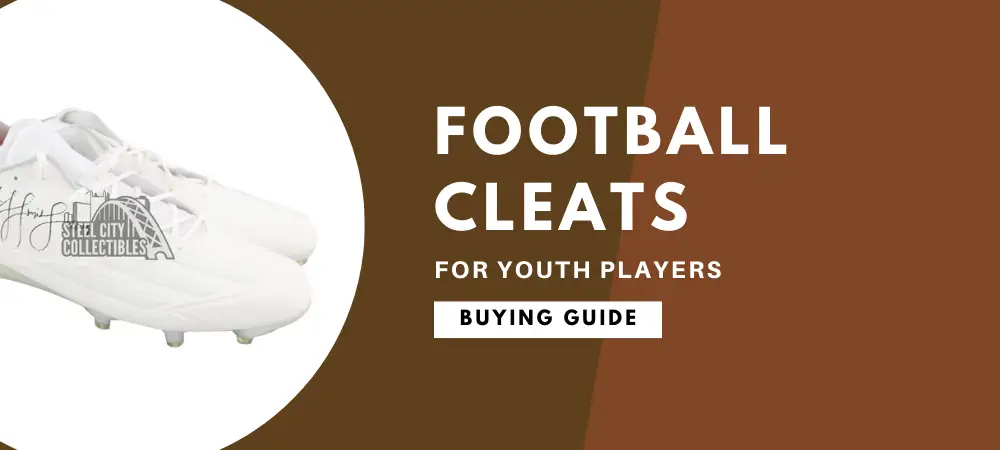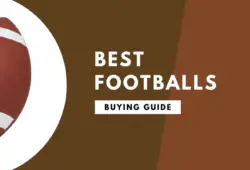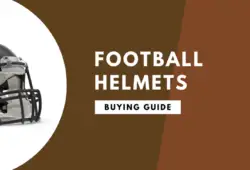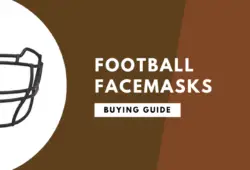Finding the right kind of athletic wear is challenging for anyone, but more so for kids who play football.
Many parents often end up getting an adult cleat in a smaller size by that is the wrong approach.
Youth cleats are designed very differently from adult cleats because the players have different needs regarding traction, comfort, support and ankle protection.
A good pair of youth football cleats doesn’t have to cost you a fortune, but you will have to undertake a good deal of research to find the ideal cleat.
No need to worry though, because this comprehensive review outlines all you would need to know about youth football cleats.
Table of Contents
Best Youth Football Cleats
This stylish cleat performs as great as it looks.
The conical studs at the bottom of the shoe are stable and provide great traction. In addition to that, the studs have been configured to provide rotation traction for added stability.
Besides the TPU outsole is safe even when the kids happen to step on each other.
This lightweight shoe has a supple upper and a padded collar for extra support and cushioning.
- Has cool color choices
- Lightweight feel
- Soft and comfortable design
- Provides an accurate fit
- The studs are configured for rotational traction
- It’s a little challenging to put on the narrow fitting shoe
Kids who don’t like flashy colorful cleats will love the zephz WideTraxx youth football cleat.
The cleat comes in an EE width which means that it would be perfect for wider feet as is the case with most kids.
Additionally, the Mid-Cut design offers ample ankle support but without restricting the young athlete.
The TPU outsole comes with rubber studs attached to it, and they are perfectly configured for stability and maximum traction.
- Perfect football cleat for wide feet
- A Mid-Cut style for ankle support
- Durable synthetic upper
- Safe rubber cleats
- Have good shape retention
- Only available up to size 6
This High-Cut cleat would be perfect for linemen who are continually making lateral movements while on the field.
Despite the style, the shoe is still pretty lightweight so the player won’t feel weighed down.
The synthetic upper wraps closely around the foot to give a locked-in, precise fit.
The meshed tongue keeps the foot well ventilated while the 4D foam footbed has a foot-forming design for a comfortable, customized fit.
- Surprisingly lightweight
- A High-Cut style for ample ankle protection
- Has a comfortable foot-forming 4D foam insole
- Numerous cleats offer added ‘bite’ for grip and acceleration
- Meshed tongue for ventilation
- The sizing runs small
This is the kind of youth football cleat which guarantees your kid is perfectly protected throughout the match.
The Mid-Cut design of this football cleat offers great ankle support while still allowing for flexibility and some maneuverability.
Additionally, the ironskin toe box is designed for maximum protection and durability.
One cool factor is that the UV-sensitive tongue tag changes color in the sun. How cool is that?
The shoe not only enhances your performance, but it helps confuse the opponents as well!
- Durable synthetic upper
- Comfortable EVA insole
- Offers great toe and ankle protection
- Has a breathable mesh lining
- Has heel and tongue tabs for easier entry
- Require some time to break-in
These slip-on cleats come with a soft knit sock collar.
The fly knit mesh provides a sock-like intimate feel around the ankles which enhances support for young players.
The same time, the design allows players to perform with speed and agility without feeling restrained.
The lightweight upper provides a comfortable seamless fit while the antimicrobial inner lining prevents the growth of odor-causing bacteria.
The hollow spikes on this cleat are ideal for use on artificial turf while the cushioned heel provides enhanced support and stability.
- Has an antimicrobial top lining
- Comfortable sock collar design
- Soft and lightweight
- Offer good arch support
- Firmly sewed for durability
- The shallow studs can only be used on artificial turf.
The Under Armour Kids’ Highlight Rm Jr. football cleat comes with a performance synthetic upper built for durability and a supportive fit.
The textile collar further aids the excellent fit of the shoe.
An external TPU ankle cage provides the ultimate ankle support and stability against lateral movements.
On the other hand, the open-holed meshed tongue ensures that the High-Cut cleat stays ventilated even in warm weather.
- Lightweight fit
- Durably constructed
- Comfortable EVA sock liner
- Provides amazing support and stability
- Has a mesh tongue for enhanced ventilation
- Sizing runs a bit small
Parents are sure to love the fact that the synthetic upper of this youth football cleat is very easy to clean.
Besides that, this well-priced affordable cleat has the look of an expensive high-end cleat, so that’s a plus.
The shoes are designed for use by toddlers.
So, it’s a good thing that they are very comfortable and lightweight enough to be used by kids as young as two years old.
The molded TPU outsole is perfect for use on firm playing fields while the stitching is strong and enhances the durability of the shoes.
- Vibrant conspicuous design
- Extremely easy to clean
- Lightweight
- Ultra-comfortable fit
- Very affordable
- Provides a narrow fit
These youth soccer cleats come with a dynamic fit system.
The system allows you to cinch your foot by lacing further up, therefore giving your foot an incredible lockdown.
Additionally, the 12-cleat configuration provides impressive traction on both wet and dry natural grass fields.
The outsole and cleats are all made from TPU which is pleasantly lightweight and safe for use on youth football cleats.
- Uses a dynamic fit system for a snug and supportive fit
- Provides incredible foot lockdown
- Good ankle support
- Excellent traction
- Well-padded for comfort
- They fit a bit too narrow
When they rolled out the Kids’ Adizero 5 Star 7.0, it is safe to say adidas impressed a lot of football players.
The synthetic leather construction of this shoe is incredibly lightweight.
This allows the young athletes to soar at top speed without feeling weighed down.
Additionally, the synthetic leather construction resists abrasion and can stand up well to harsh weather conditions.
You, therefore, get a very durable youth football cleat.
- Bright, eye-catching design
- Very lightweight
- Sturdy and durable shoe
- Unrestrictive Low-Cut style
- Provides a perfect fit
- Offer minimal ankle support
The Under Armour Hammer Mid RM Junior football cleats come with a traditional lace-up design which means that you can adjust the fit accordingly for better comfort.
Another advantage of this shoe is that it comes with a pull-on tab, therefore, making it very easy to wear or take off the shoes.
The padded tongue and collar are other features that allow for enhanced comfort of the player in addition to providing shock absorption.
- Comfortable die-cut EVA insole
- Aggressive cleat design for ultimate traction
- Lightweight feel
- Supportive Mid-Cut design
- They fit snug and comfortable
- Not ideal for players with wide feet
Types of Youth Football Cleats
Molded Football Cleats
Molded football cleats have permanently attached spikes on the bottom of the shoe. The spikes could either be made from Thermoplastic Polyurethane (TPU) or rubber.
TPU is basically a hard plastic, and these spikes work best on artificial turf. Hard molded football cleats are lightweight and which allows for speed and performance.
They are therefore very appealing for youth and collegiate players. The shoe provides incredible traction on firm ground.
Rubber molded cleats have a softer feel when compared to TPU spikes. Rubber spikes often have deep grooves and wide studs.
This design makes them suitable for use on grassy terrain whereby the shoe won’t dig excessively into the ground.
In addition to that, rubber molded football cleats provide proper shock absorption and are very comfortable.
Additionally, the shoe doesn’t cause much hard when a football player accidentally steps on another. All these properties make rubber cleats a great entry-level football shoe.
Molded cleats all come ready to wear, so there’s no fuss with the spikes. The shoe is conveniently easy to use. Additionally, they tend to require less maintenance compared to detachable cleats.
Besides, the price point is quite affordable too, ideal for youth leagues, high schoolers and casual players.
Detachable Football Cleats
When it comes to detachable football cleats, the studs at the bottom of the shoe can easily be changed or replaced.
This design allows for great versatility which is great if a player will be using the shoe in uncertain weather conditions or on a variety of fields.
You get to not only choose the stud size, but you can change the stud configuration as well, as suits different player positions.
Shorter studs would be ideal for use on dry ground. Longer studs would be suitable for use on wet surfaces. With the longer stud, the player can dig into the wet, uncertain surface for proper traction.
Because of the precision offered, detachable cleats are popular amongst advanced high school, collegiate, and pro football players.
These shoes are more expensive than molded cleats, seeing as the spikes are longer and stronger.
Youth Football Cleat Styles
Low-Cut Cleats
They stop right before the ankle, thereby don’t have an extended top. These are the lightest football shoes you can buy and allows for maximum maneuverability of the player.
Designed for Wide Receiver, Running Back, and Defensive Back player positions.
Mid-Cut Cleats
The shoe extends to the ankle, therefore, offering support but without restricting the player’s movements.
Designed for Linebacker, Quarterback, Tight End and Running Back player positions.
High-Cut Cleats
These shoes offer the most ankle support. The cleat laces up above the ankle, thereby boosting support. The downside is that they affect the player’s mobility.
Designed for Defender, Offensive Lineman and Defensive Lineman player positions.
Things to Consider To Find The Best Youth Football Cleats
Material
Leather and synthetic materials are what are commonly used to manufacture youth football cleats.
Leather is very comfortable and can stretch to conform to the shape of the wearer’s foot. In addition to that, the material breathes well and is exceptionally durable.
The disadvantage, however, is that leather has great absorbency. So, when playing on a wet field, the shoe becomes heavier, making it difficult for your child to run in them.
Synthetic materials are more inexpensive compared to leather. Additionally, they aren’t as absorbent and are also easier to clean.
Besides, synthetics can hold more colors and designs and so players have a wider variety of shoe designs to choose from.
Thermoplastic polyurethane (TPU) is a popular synthetic material used for cleats. It is preferred for its water resistance and lightweight feel in addition to its durability.
Pebax® is a thermoplastic elastomer known for its all-weather suitability. The lightweight material is supportive, comfortable and offers resistance to impact and flex fatigue.
EVA is a flexible and durable material capable of withstanding extreme cold and heat. It is water-resistant, doesn’t crack with age and can absorb and withstand high impacts.
Ultimate you want a cleat that provides durable build quality using high-quality solid materials.
This way you will be sure you’re getting value for your money and investing in a shoe that will last at least till the end of the season.
Protection
The material of a youth football cleat should be soft enough to allow for flexibility, but hard enough to offer the required level of protection.
Often, you may find that football cleats designed for older kids say between ages 9-14, come with multiple cleats on the heel.
This is done to enhance even distribution of pressure, thereby avoiding conditions such as calcaneal apophysitis.
A good cleat ought to enhance the player’s gait and biomechanics, all the while keeping them stable and well supported. Ankle support is something to consider, as well.
You might not dwell much on this when dealing with kids, but older children require some degree of ankle support. Which is why a Mid-Cut cleat style is the most popular of all three styles.
Style
When considering the style of the shoe, take into consideration the players position on the field.
For instance, while a lineman would be perfectly okay with a High-Cut cleat, the same cleat style would be too bulky and restricting for a wide receiver.
High-Cut cleats best suit the players who continuously make lateral movements, while Low-Cut cleats are designed for players who need speed and agility on the field.
A Mid-Cut style tends to be the compromise between the two. Hence why the style can be worn by pretty much any player regardless of their position.
Try to do some research as you try to find out the demands of the game on your kid’s lower extremity depending on their playing position.
This will make a huge difference when it comes to finding the right cleat style unique to their situation.
Cleat Type
When choosing a cleat type, consider the age and skill level of the intended wearer.
Younger players prefer hard molded cleats because they are a no-fuss option seeing as the shoe is ready for use just the way it is.
Detachable cleats are better suited for older, more advanced players who understand how to adjust the shoe so that it suits their desired traction on different field surfaces.
Detachable cleats are generally more expensive than hard molded cleats.
So, the other reason why they are better suited to advanced players is that they make for a worthy investment and the player will get some good use out of them.
Playing Field Type
Which kind of field will you be playing football on? Is it synthetic turf or fresh grass?
Fresh grass provided more cushion and give, so you might get away with a shoe having low amounts of cushioning.
At the same time, a grass surface tends to change depending on the weather conditions. Grass has a good grip in summer, but it gets slippery on a rainy day.
That being said, detachable cleats are preferred for use on grass because then, you have the option of swapping out the cleats.
Swap shorter cleats for longer ones during rainy weather then switch back to shorter studs when it is sunny.
Synthetic turf offers a constant surface al throughout the year regardless of whether it’s rainy or sunny. As a result, you would be okay using molded cleats for artificial turf.
Different shoes offer different levels of comfort on different field surfaces. For instance, a particular shoe may play very well on dry grass, but you’d feel uncomfortably using them on turf.
The reason is that one field surface has more cushioning than the other. So, cushioning and comfort are other aspects to look into regarding playing field type.
How to Choose the Right Size of Youth Football Cleats?
Never assume your child’s cleat size. When it comes to cleats, you will often find that your child wears a very different size from other shoes they own.
That being said, the general rule to follow here is measure twice, buy once.
If you cannot have your kid with you when buying the football cleats, then consider having their foot measured by a professional.
You may also choose to do it yourself. Just make sure the measurements are taken while the child is standing upright, fully weight-bearing.
Another thing to remember is to measure both feet. Yes, your child’s left foot might not be the same size as their right foot. If this is the case, then go for the larger foot’s shoe size.
When you think you’ve found the right size cleat, check the toe box space. Beyond the child’s big toe, the toe box space shouldn’t be larger than an adult’s thumb width.
This way, the shoe fits snug, but then there’s still some room for the child’s feet to grow. When the toe box space is too big, then the child will have difficulty running or even walking in the shoes.
Check the space left at the back of the shoe as well.
If the shoe fits correctly, then you will be able to insert your pinky finger in the heel of the shoe while the child is wearing the cleat. Just the pinky finger, though; no more, no less.
Generally, kids’ feet are wider; then they lengthen with age.
When buying youth football cleats, therefore, make sure the width of the cleat is appropriate, and it’s not just the length of the shoe that fits.
An additional tip is to shop for football cleats say some time around later afternoon.
Our feet tend to swell and get bigger as the day progresses so your feet would be bigger later on in the day than they were in the morning.
When going to try out football cleats, it would also be wise to carry the sports socks your child wears.
This way, you can take into account any extra thickness resulting from the socks and adjust the cleat size accordingly for a perfect fit while wearing playing socks.
Fit and comfort go hand in hand. Do not buy an ill-fitting cleat hoping that it will break in and become more comfortable over time.
In fact, when purchasing youth football cleats, avoid shoes that will need to be broken in.
A shoe that is comfortable right out the box is always preferred.
The comfort level of a football cleat is determined by the upper material, the lacing construct, the shape of the shoe, and the depth of the toe box.
How to Clean Youth Football Cleats
Step 1: Start by removing the insole, if detachable, and the laces as well.
Step 2: Knock the cleats together to shake off any dirt and debris.
Step 3: Using an old toothbrush, dry scrub to remove any hard-to-remove grime. Wipe away any remaining dirt using a clean cloth.
Step 4: Mix some laundry detergent in cool water. Dampen a cloth in the soapy mixture and use this to wipe the exterior of the shoes.
You may use a soft-bristled brush to scrub off stubborn dirt. Do not submerge the cleats in water.
Step 5: Wash excess dirt off the cloth then dampen it in the soapy mixture again and continue wiping the cleats until they are thoroughly cleaned.
Once you are done with the exterior, clean the interior of the shoe.
Step 6: Take another dry clean cloth and dampen it with hydrogen peroxide. Use this cloth to wipe and disinfect the inside of the cleats.
Allow the youth football cleats to dry thoroughly before use. If the cleats get wet on the inside, stuff with newspapers and let sit overnight.
The newspapers will help with moisture absorption and shape retention.
Step 7: Wash the removable insole and laces in soapy water. Rinse and allow to dry completely before putting them back in the cleats.
Step 8: If you have leather cleats, polish them after cleaning to enhance their color. You may also use a leather conditioner to replenish the leather’s natural oils.
This video might help give a better idea on how to clean youth football cleats:
FAQ For Youth Football Cleats
Are Low Top Cleats Good for Football?
Low top cleats stop just below the ankle, thereby allowing for maximum maneuverability. Additionally, these shoes are lightweight, therefore allowing the player to play with speed and agility.
For these reasons, a low top football cleat would be better suited for wide receivers, running backs and defensive backs.
The players get to enjoy an untouchable feeling in the open fields, but keep in mind that this shoe offers very little to no ankle support.
Ankle support is not a huge consideration for younger players, however. Besides, you can enhance the ankle support by wearing the low top cleat with thicker athletic socks.
Is There A Difference Between Youth Football and Baseball Cleats?
Yes, there is.
At a glance, football and baseball cleats may look quite similar. However, the two shoes are designed for different sports with different player needs in mind, so they do not offer the same performance.
The first striking difference comes in the stud type and configuration.
Baseball shoes are not made for contact or for stepping on other players. The blade-like studs are all of the same length and work best on dry ground.
For football cleats; however, the studs all come in different lengths, and their configuration on the shoe provides balance and stability.
Additionally, football cleats are designed to be heavier and offer more support, while baseball cleats are lighter.
Can You Wear Soccer Cleats for Football?
Soccer cleats and football cleats are both designed for traction, speed and stability. Hence a lot of people tend to think that the two shoes can be worn interchangeably.
That is not entirely true, however. Every shoe is designed with a different function, height, weight, material and stud type and configuration.
That being said, soccer cleats are very versatile and can be worn in other sports. While you cannot say, wear football cleats to play soccer.
As a matter of fact, for some football positions, the player may comfortably wear a soccer cleat without it have an impact on their game.
Wide receivers, for instance, can wear a soccer cleat seeing as it provides the same mechanics they need.
So yes, you can wear soccer cleats for football and still be safe and adequately supported.
Are Youth Football Cleats Unisex?
Most kids’ football cleats will be unisex, while youth football cleats designed for older children will come gender-specified.
This is because kids don’t have their bodies fully formed yet. So, there isn’t much of a difference between the girls and the boys.
With time, as they grow, then their bodies begin to mold accordingly, and gender differences become more prominent.
Girls’ feet only begin to narrow once they reach adolescence, so before then, the two can comfortably share a shoe.
The only thing you might want to pay attention to is the color whereby you can get a hot pink cleat for a girl and a blue cleat for a boy, both in the same style and model.
Should You Buy Football Cleats A Size Bigger?
No. Size is an extremely crucial factor when it comes to youth football cleats because the player needs a shoe which provides a proper fit.
Most parents tend to go for a shoe that’s slightly bigger so that the player can grow into it, but this is the wrong approach.
When the cleat is too large, it risks causing an injury to the player, and you wouldn’t want that, now would you?
Besides, eventually, even the most expensive football cleats will last maybe a season. So, don’t plan too far ahead hoping you can get the shoe to last longer if you get a bigger size. It won’t.
Get a fitting cheaper cleat, as opposed to a bigger, more expensive cleat.




